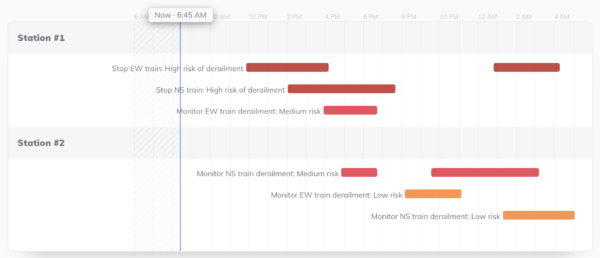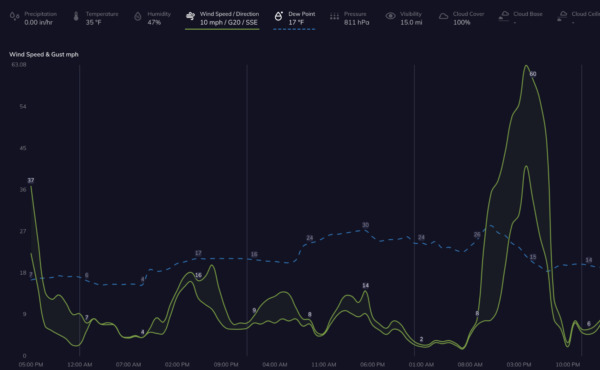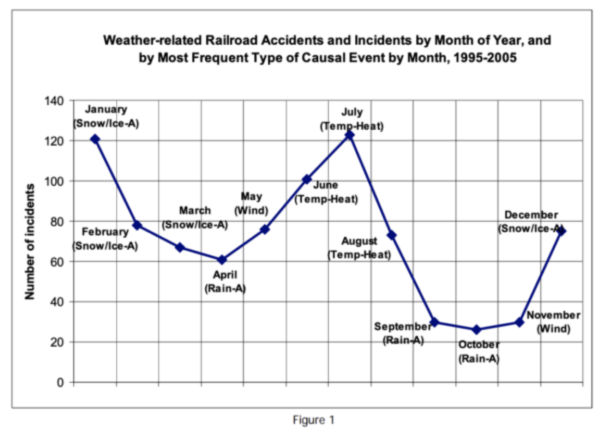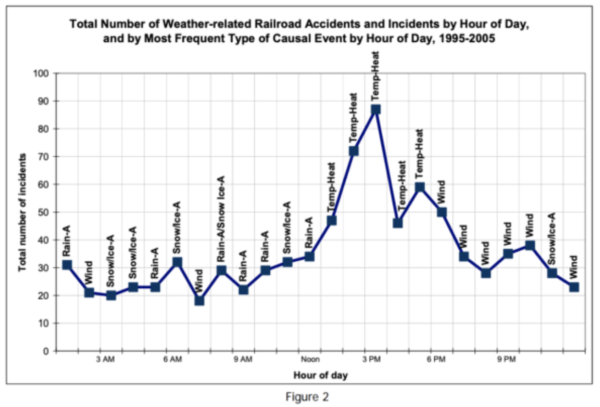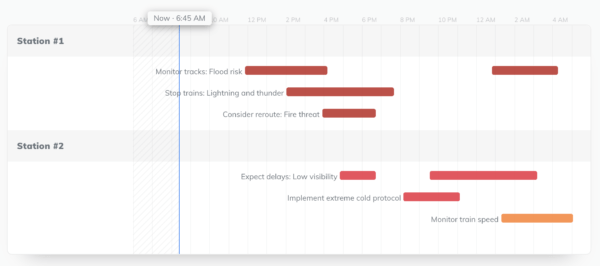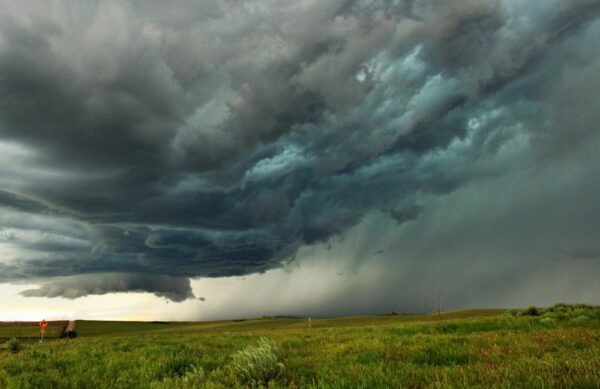The operational team at a major railway was working to finalize departure schedules for the coming days.
That’s when they spotted something on their weather intelligence dashboard: An unexpected high wind storm was coming in three days and was forecast to hit one of their trains en route, potentially derailing cars and causing millions in damages.
The team quickly visualized the incoming wind and the specific locations that would be impacted:
They worked quickly to reschedule and re-route their trains to avoid the incoming storm. Sure enough, three days later the major wind storm hit, but thankfully there were no trains on the track to be damaged or derailed.
Crisis averted.
The team was able to see incoming winds of 50+ MPH 3 days out, understanding the impact down to the rail-level. With that data on-hand, they proactively adapted to the incoming storm and saved the company millions in damages.
The Risk of Ignoring Weather
The railroad industry has become even more essential to the day-to-day operations of the US economy due to the impact of COVID-19. As the world’s most productive, safest, and lowest cost freight system, rail is an essential service that is only growing.
But there’s a problem. The industry suffers from hundreds of millions in weather related damages every year, and it’s an issue all 7 of the Class I railroads and 600 short-line and regional railroads suffer from throughout the 140,000 rail mile system across the United States.
As you know, the average cost of a derailment is — at minimum– $2 million.
But while derailments are unusual, delays are a daily occurrence and there’s also a high cost to weather-driven delays. The average cost of a delay is approximately $500 per hour and the average duration of a delay is 3 hours. Those numbers can very quickly add up across the many miles of track across the country.
A study done by the Volpe National Transportation System identified additional major categories of weather related damages and the average cost per incident, which include:
- Collision: $150,285
- Obstruction: $77,971
- Fire/Violent Eruption: $35,000
- Other: $80,797
In addition to these costs, the average number of injuries/deaths per incident include:
- 2 injuries or deaths for each derailment incident
- 1 injury or deaths for each collision/other incident
- 0.5 injury or deaths for each obstruction incident
While these are scary numbers, what’s more concerning is the rate at which annual train financial damages can increase if not managed properly. For instance, a study done by Princeton showed how annual train financial damages increased 38% over the course of just a 9 year period.
Weather Events that Make an Impact
While there are a number of weather events that can impact railroad operations, only a few can cause serious issues like delays or derailments. These can be categorized by the percentage of total incidents each cause:
- Temperature extremes (heat, cold, variation) represent 26.1% of railroad weather incidents
- Liquid precipitation: 23.1%
- Wind velocity: 20.9%
- Frozen precipitation: 18.5%
- Fog: 2.6%
- Other: 2.1%
- Frozen load: 1.2%
- Slide (snow, mud, rock): 5.0%
- Lightning: 0.5%
Given seasonality, Volpe’s report goes on to highlight which months on average represent the greatest weather risk (which naturally will vary by location), as well as the time of day when each event occurred.
There are some obvious takeaways from these charts like snow risk in January and heat risk in July. However, the data is simply not actionable at the hyperlocal level.
The aggregation of the seasonality data along with the time of day data is where things start to become more valuable if combined with additional data sources. For instance, note the morning brings the highest risk of precipitation, middle of the day is susceptible to temperature variability, and later in the day sees the highest percent of wind related accidents.
How Weather Improves Best Practice Rail Operations
Railroad operations teams have to make a number of decisions in and around the weather today, which Volpe’s study goes on to document.
Essentially, the three main Clarus attributes consist of sky, track, and hydro. (CBRN is an additional hazard but not one that’s relevant to this discussion.) Here are a few of the types of decisions each of these core attributes impact and how rail operations specifically can better minimize risk.
Attribute 1: Skies
Elements: This includes temperature variability, wind, tornadoes, precipitation, visibility, and air quality
Insights and decisions:
- Crosswinds that move and shift weight or stop train
- Usage of high profile railcars and double-stacked container trains
- Go/no-go departure/arrival decisions
- Scheduling and delivery
- Staff safety
- Cargo risk
- Delays and stoppage
- Visibility risk from fog or structural risk from wind gusts
- Operational improvements, procedures and protocols
Attribute 2: Track
Elements: Track condition from wetness, temperature, ice, snow, water, surface temperature and moisture
Insights and decisions:
- Trip time ETAs
- Staffing and scheduling
- Contingency plans
- Dispatch, routing, and re-routing in real time
Attribute 3: Hydro
Elements: Risk from nearby rivers, streams, lakes, coast including soil saturation, water levels, flow rate, flood stage, wave height
Insights and decisions:
- Soil saturation impacting rails and necessitating rail inspection
- Routing and rerouting in real time
- Optimizing connections for intermodal transfers
- Strategizing railcar placement and staging equipment
Each specific type of weather event has a real impact on railroad operations, from small to large. For rail operators, trying to predict and understand which weather events will happen, when, where, and the impact quickly becomes a 24/7 job.
Because this is so difficult to predict and forecast, the railroad industry has been operating with a heightened level of risk exposure for decades. Until now, there hasn’t been a way to automate risk impact across all trains and rails during every second of every day.
How Weather Intelligence Keeps Trains Running Smoothly
Thankfully, these weather elements, operational nightmares, and the deep financial implications of the weather on your railways don’t have to mean immediate losses for your business.
With a weather intelligence platform and insights dashboards, you can see the aggregate of hundreds of millions of weather data points to get actionable operational guidance across your hundreds, thousands, or tens of thousands of locations.
The Insights Dashboard tracks all of your rails, trains, and schedules days in advance, and alerts you when any specific locations are at risk of weather. You can manage and optimize to custom weather impact use cases or use prebuilt templates developed alongside the rail industry.
It’s about more than just the forecast. The impact of upcoming weather on your operations takes into account historical, real-time, and forecasted data for all of your locations. In addition your team will know the exact steps to proactively mitigate the impact of operational, financial, and safety risks, while also being able to take advantage of new opportunities to unlock new revenue streams.
Teams can also automate employee communications and protocols to ensure one source of truth with automated messaging and alerts. Instead of sending out a manual email, everyone will automatically be notified when a storm is incoming.
It’s clear that weather has always had a massive impact on rail operations. But it’s only recently that operators have been able to access the necessary data to power proactive decision-making. With weather intelligence on your side, you can easily save your rail company millions.
Want Better Rail Operations?
See How Tomorrow.io Can Help
